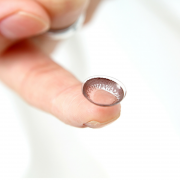Blind as a Bat and Other Animal Sight Stories…
Even if you don’t understand exactly how the eye works, you understand what your human vision allows you to see. A person with healthy eyes and normal vision expects to be able to differentiate colors and shapes, to be able to focus on objects far away and close up, and to adjust to varying amounts of light both outside and inside. We have good binocular vision (both eyes seeing together) and a fair amount of peripheral vision off to the sides. We also know our vision limitations: we don’t expect to see very well in the dark, we know it takes a few moments to adjust to a very bright light or very low light, and we have to turn our heads to see anything too far to the side or behind us.  But have you ever thought about how animals see? Do you wonder why your cat can navigate your house night better than you? Why fish have eyes on either side of their heads? If your dog really is colorblind? And if the old adage “blind as a bat” is really true? Well this post is here to clear up some of these questions for you. We’re hear to clear up some myths, answer some questions, and provide you with some really fun facts to impress your friends (or help you win Trivial Pursuit). :-)Read on to learn how some of our vertebrate friends see the world…All animals (including humans) have eyes that have developed to satisfy the needs of their particular species. Humans, for instance, have very good color vision. This is thought to have developed from the need to determine which fruits and vegetables were most ripe and nutritious. Because our senses of smell, sound, and touch are not quite as strong as our sight, we depend heavily on vision to move through life. Other animals depend more heavily on other senses. Bats, for instance, see with their ears (more on that later).For now, let’s take a trip down to the very bottom of the ocean. The light here has all been absorbed by the water, so the world is dark. The fish that live here tend to have very small and often non-functional eyes. They rely on other senses like lateral line senses to survive. The fish a little further up in the water have developed eyes on the sides of their head that allow a very wide range of vision around them to look for predators, but very little in the way of binocular vision (using both eyes together). This makes depth perception and judging distances very difficult. There is virtually no color vision below about 300 feet in the water, so fish in mid ocean depths (as well as sharks and rays) are usually colorblind.
But have you ever thought about how animals see? Do you wonder why your cat can navigate your house night better than you? Why fish have eyes on either side of their heads? If your dog really is colorblind? And if the old adage “blind as a bat” is really true? Well this post is here to clear up some of these questions for you. We’re hear to clear up some myths, answer some questions, and provide you with some really fun facts to impress your friends (or help you win Trivial Pursuit). :-)Read on to learn how some of our vertebrate friends see the world…All animals (including humans) have eyes that have developed to satisfy the needs of their particular species. Humans, for instance, have very good color vision. This is thought to have developed from the need to determine which fruits and vegetables were most ripe and nutritious. Because our senses of smell, sound, and touch are not quite as strong as our sight, we depend heavily on vision to move through life. Other animals depend more heavily on other senses. Bats, for instance, see with their ears (more on that later).For now, let’s take a trip down to the very bottom of the ocean. The light here has all been absorbed by the water, so the world is dark. The fish that live here tend to have very small and often non-functional eyes. They rely on other senses like lateral line senses to survive. The fish a little further up in the water have developed eyes on the sides of their head that allow a very wide range of vision around them to look for predators, but very little in the way of binocular vision (using both eyes together). This makes depth perception and judging distances very difficult. There is virtually no color vision below about 300 feet in the water, so fish in mid ocean depths (as well as sharks and rays) are usually colorblind. Fish higher up have some color vision, but even small depths of water absorb color light, so color vision is not a necessity for our finned friends. Fish don’t even rely on their eyes for all of the light they need to perceive. Some fish have light sensitive areas in the center of their forehead and even on their skin or tail! Creatures in the sea can vary greatly within their species however; some fish have eyes that are on stalks that come off the top of their heads, eyes that allow the fish to see above water with the top half and below water with the bottom half, and even telescopic eyes that look straight up! Regardless of what they look like, fish do not have tear producing glands like humans. They don’t need them because their eyes are constantly being bathed and lubricated. (They probably don’t have trouble with dry eyes!)Moving up onto solid ground, let’s take a look at the way our favorite four legged friends see the world. Cats and dogs have similar vision. They both have good night vision and are red-green color blind. This means that the spectrum of colors that cats and dogs see is one that is brighter and less detailed than what humans see. They can distinguish blues from other colors but have trouble with browns, reds and greens. What dogs and cats sacrifice in detail and color though, they make up for with excellent night vision (especially in cats) and very good motion detection. These are skills that a carnivorous hunter needs to survive. A big difference in the cat eye and the dog eye you may have noticed is that cats have large round pupils when the iris is open, but when closed, the pupil has a narrow slit shape. This structure allows for very quick adjustment of the pupil in varying light conditions. This means cats can adjust to a dark room in a matter of seconds rather than the minutes that it may take a human. A benefit like this comes at the expense of depth of field and close-up focus; cats have difficulty focusing up close much like an older person who needs reading glasses.
Fish higher up have some color vision, but even small depths of water absorb color light, so color vision is not a necessity for our finned friends. Fish don’t even rely on their eyes for all of the light they need to perceive. Some fish have light sensitive areas in the center of their forehead and even on their skin or tail! Creatures in the sea can vary greatly within their species however; some fish have eyes that are on stalks that come off the top of their heads, eyes that allow the fish to see above water with the top half and below water with the bottom half, and even telescopic eyes that look straight up! Regardless of what they look like, fish do not have tear producing glands like humans. They don’t need them because their eyes are constantly being bathed and lubricated. (They probably don’t have trouble with dry eyes!)Moving up onto solid ground, let’s take a look at the way our favorite four legged friends see the world. Cats and dogs have similar vision. They both have good night vision and are red-green color blind. This means that the spectrum of colors that cats and dogs see is one that is brighter and less detailed than what humans see. They can distinguish blues from other colors but have trouble with browns, reds and greens. What dogs and cats sacrifice in detail and color though, they make up for with excellent night vision (especially in cats) and very good motion detection. These are skills that a carnivorous hunter needs to survive. A big difference in the cat eye and the dog eye you may have noticed is that cats have large round pupils when the iris is open, but when closed, the pupil has a narrow slit shape. This structure allows for very quick adjustment of the pupil in varying light conditions. This means cats can adjust to a dark room in a matter of seconds rather than the minutes that it may take a human. A benefit like this comes at the expense of depth of field and close-up focus; cats have difficulty focusing up close much like an older person who needs reading glasses.  One more very important structure in the eyes of cats and dogs is something called the tapetum lucidum. In order to see as well as possible at night, dogs and cats eyes need to let in as much light as possible. When light comes into the eyes, some of it is inevitably missed by the light receptor cells (called rods). In the human eye, that is the only light that can create signals that let us see something. In dogs and cats (and quite a few other nocturnal hunters), the light is reflected off the tapetum lucidum to get a second chance to be picked up by the rods in the eye. The reflection from this layer of the eye is the eye shine that you see from your cat or dog’s eyes at night.One might think that soaring around hunting from the air requires very sharp vision and focus. Not so. Meet our belfry friend, the bat. Bats have very bad vision. Especially with their distance vision. And because they only hunt after dusk, bats have little need for color vision, so they are color blind as well. The saying “blind as a bat” , however, is only partially true. While their vision may be less than par, they actually “see” with a system called echolocation. The bat sends out sound waves (which are actually more accurate than light waves) that bounce off of the unlucky prey and send an echo back to the bat. This is an excellent way for the bat to locate prey even at great distances. Once the bat is close enough, the final assault is made using their visual sight. Some carnivorous bats are actually thought to use sonar to detect details like ripples made by fish on the water. So, while they may not have incredible vision with their eyes, bats can “see” their prey more clearly than almost any other animal.Birds are a different story completely. Have you ever watched a bird flying high above the ocean suddenly swoop down and pull a fish from the water? Birds see a world that is not only in color, but that is
One more very important structure in the eyes of cats and dogs is something called the tapetum lucidum. In order to see as well as possible at night, dogs and cats eyes need to let in as much light as possible. When light comes into the eyes, some of it is inevitably missed by the light receptor cells (called rods). In the human eye, that is the only light that can create signals that let us see something. In dogs and cats (and quite a few other nocturnal hunters), the light is reflected off the tapetum lucidum to get a second chance to be picked up by the rods in the eye. The reflection from this layer of the eye is the eye shine that you see from your cat or dog’s eyes at night.One might think that soaring around hunting from the air requires very sharp vision and focus. Not so. Meet our belfry friend, the bat. Bats have very bad vision. Especially with their distance vision. And because they only hunt after dusk, bats have little need for color vision, so they are color blind as well. The saying “blind as a bat” , however, is only partially true. While their vision may be less than par, they actually “see” with a system called echolocation. The bat sends out sound waves (which are actually more accurate than light waves) that bounce off of the unlucky prey and send an echo back to the bat. This is an excellent way for the bat to locate prey even at great distances. Once the bat is close enough, the final assault is made using their visual sight. Some carnivorous bats are actually thought to use sonar to detect details like ripples made by fish on the water. So, while they may not have incredible vision with their eyes, bats can “see” their prey more clearly than almost any other animal.Birds are a different story completely. Have you ever watched a bird flying high above the ocean suddenly swoop down and pull a fish from the water? Birds see a world that is not only in color, but that is  more colorful and sharper than even humans can imagine. This only makes sense for their survival. Remember the light receptor rods that we talked about earlier? Well, another tiny important cell in our eyes is the color sensitive cone cell. The animals that we have talked about up to now all have a larger number of rods than cones in their eyes (and a larger number of rods than humans have). The primary function of eyes structured like this is to receive as much light as possible. The primary function of eyes with more cones is to see color and detail. Humans have about 10,000 cones per square millimeter. Many songbirds and predator birds have up to 12 times this number! That means that if you were a bird, the colorful guy above might look even more colorful!! Some birds even have an extra type of cone that allows them to perceive UV light. It is speculated that birds’ feathers reflect UV light in a way that might indicate qualities like status to other birds. Extra cells like this allow birds to see details 2 to 3 times farther away than humans can.As you can see, because vision needs vary so greatly between species, eye structure does too! I for one feel lucky to have all those photo-receptive cone cells to see the beautiful spring flowers or a stunning sunset. And while night vision might be nifty, the crispness and clarity that our eyes can produce (for many, with correction) is too amazing to give up. All this incredible information only reminds us of what Dr. Golson and the entire Envision Team wants you to remember: even if you are seeing clearly, yearly eye exams are of utmost importance for ensuring that all those rods and cones remain healthy and are able to function like they should. Because unfortunately, we don’t have an echolocation system to fall back on.
more colorful and sharper than even humans can imagine. This only makes sense for their survival. Remember the light receptor rods that we talked about earlier? Well, another tiny important cell in our eyes is the color sensitive cone cell. The animals that we have talked about up to now all have a larger number of rods than cones in their eyes (and a larger number of rods than humans have). The primary function of eyes structured like this is to receive as much light as possible. The primary function of eyes with more cones is to see color and detail. Humans have about 10,000 cones per square millimeter. Many songbirds and predator birds have up to 12 times this number! That means that if you were a bird, the colorful guy above might look even more colorful!! Some birds even have an extra type of cone that allows them to perceive UV light. It is speculated that birds’ feathers reflect UV light in a way that might indicate qualities like status to other birds. Extra cells like this allow birds to see details 2 to 3 times farther away than humans can.As you can see, because vision needs vary so greatly between species, eye structure does too! I for one feel lucky to have all those photo-receptive cone cells to see the beautiful spring flowers or a stunning sunset. And while night vision might be nifty, the crispness and clarity that our eyes can produce (for many, with correction) is too amazing to give up. All this incredible information only reminds us of what Dr. Golson and the entire Envision Team wants you to remember: even if you are seeing clearly, yearly eye exams are of utmost importance for ensuring that all those rods and cones remain healthy and are able to function like they should. Because unfortunately, we don’t have an echolocation system to fall back on.




